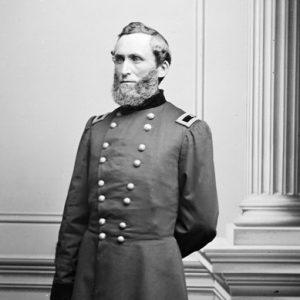calsfoundation@cals.org
Benjamin Mayberry Prentiss (1819–1901)
Benjamin Mayberry Prentiss served as a major general in the Union army during the Civil War. He most notably served as the Federal commander at the Battle of Helena and was captured leading his division at the Battle of Shiloh.
Benjamin Prentiss was born in Belleville, Virginia, on November 23, 1819, to Henry Leonidas Prentiss and Rebecca Mayberry Prentiss. At the age of seventeen, he moved with his family to Marion County, Missouri, where he worked as a rope maker. In 1841, he moved to Quincy, Illinois, where he joined the militia and was active in the conflict between local citizens and members of the Church of Jesus Christ of Latter-Day Saints.
Prentiss was married twice. He and his first wife, Margaret Sowdosky, had six children. After her death, he married Mary Worthington Whitney, and they had four children.
During the Mexican War, Prentiss served as a captain in the First Illinois Infantry and fought at the Battle of Buena Vista. After the war, he returned to Illinois and practiced law. He continued to serve in the militia, eventually reaching the rank of colonel. In 1860, he ran unsuccessfully for Congress as a Republican. At the outbreak of war, Prentiss was commissioned as a colonel in command of the Tenth Illinois Infantry.
Prentiss was promoted to brigadier general on August 9, 1861, and was ordered to take command of an area in northern Missouri. Tasked with disrupting secessionist groups in the area, Prentiss served in Missouri until the following March and led troops in several skirmishes against pro-secessionist forces. Ordered to join Major General Ulysses S. Grant’s army in Tennessee, he took command of a division on April 1, 1862. Confederate forces attacked on April 6, opening the Battle of Shiloh. Prentiss was captured, along with part of his division, after defending a location that became known as the Hornet’s Nest. After being held in several prisons over the next months, he was formally exchanged in October. Rather than returning directly to the field, Prentiss was tasked with being a part of the court-martial of Major General Fritz John Porter. Porter was convicted of two charges, although Prentiss voted for acquittal.
Promoted to the rank of major general on March 13, 1863, Prentiss was given command of the District of Eastern Arkansas with his headquarters at Helena (Phillips County). Soon after his arrival, on July 4, Confederate forces launched an attack on the Federal defenses surrounding the city in an effort to influence the ongoing siege at Vicksburg, Mississippi. Prepared for a Confederate assault, Prentiss led his troops through the battle, and his skill, coupled with Confederate miscommunication and ineptitude, led to a Union victory.
After his successful defense of Helena, Prentiss was not given a new command when Federal forces in the Mississippi River Valley reorganized that autumn. Ordered to report to Washington DC to await an assignment, he instead resigned his commission. Prentiss’s first wife had died in 1860, and he cited both family and medical conditions in his resignation. Some historians believe that it is possible that Prentiss lost his command as a result of his dissenting vote in Porter’s court-martial.
Prentiss returned to Quincy, where he practiced law until moving to Kirksville, Missouri, in 1878 and then Bethany, Missouri, in 1881. Remaining active in the Republican Party, Prentiss served as a delegate to the 1880 and 1884 national conventions and was named postmaster of Bethany in 1888. He outlived his second wife, who died in 1894. Prentiss died in Bethany on February 8, 1901, and is buried in Miriam Cemetery.
For additional information:
Christ, Mark K. Civil War Arkansas, 1863: The Battle for a State. Norman: University of Oklahoma Press, 2010.
Warner, Ezra. Generals in Blue. Baton Rouge: Louisiana State University Press, 1964.
David Sesser
Henderson State University
 Military
Military Benjamin Prentiss
Benjamin Prentiss 



Comments
No comments on this entry yet.